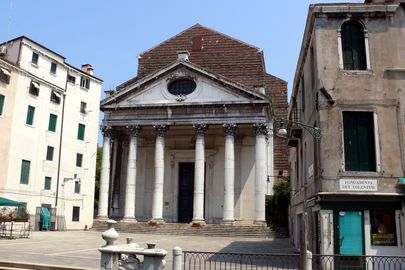

At first glance, due to the high Roman portico and absence of a dome, we have the impression that this is not a Christian church, but rather a pagan temple. However, as we enter, we see that this late Renaissance shrine is indeed a Christian place of worship and is dedicated to a very important Italian saint and mystic, Nicholas of Tolentino.
Nicholas was born in 1246 in Ancona, in the present-day region of the Marche. His parents had been childless for a long time and often prayed at the church of St. Nicolas of Myra. Therefore, when their son was finally born, they named him after the saint. He became an Augustinian friar and was ordained at the age of 25. Constantly receiving visions of angels telling him to go to the nearby city of Tolentino, the kind and generous friar moved there hoping to make peace between the Guelfs and the Ghibellines, those supporting the Pope and the Emperor respectively. In the end, though he was not very successful at brokering a peace deal - the fighting continued for about another one hundred years - Nicholas did in fact provide lots of help to the poor and suffering, especially to the local prisoners. Throughout his entire life, even when he was ill, Nicholas subjected himself to voluntary mortifications, something that in those times constituted the path to sanctity. He is also said to have performed many miracles such as resurrecting one hundred dead children, saving ships from sinking and saving the Doge's Palace in Venice from burning down. He died in 1305 and was canonized in 1446 by a Venetian, Pope Eugene IV. Nicholas from Tolentino was credited with three hundred miracles in all.
The main body of the Church of San Nicola del Tolentino was built in the last decade of the 16th century by famous Venetian architect, Vincenzo Scamozzi. It was commissioned by the Theatines religious order. The church's façade, however, with the six-column portico and the rose-windowed tympanum was added only in the beginning of the 18th century by Andrea Tirali, Yet, as we can see, the part of the façade above the triangular tympanum remains unfinished.
The layout of the single-nave interior is in the shape of the Latin cross. There are three chapels on each side, the most important of which is the one dedicated to the Correr family. It contains the tombs of three doges, Giovanni I, Francesco and Giovanni II Correr. The chapel also shelters an imaginative altarpiece dedicated to the Visitation of the Virgin by Jacopo Palma the Younger. The choir, along with the funeral monument of patriarch Gianfrancesco Morosini, was built by Baldassarre Longhena.
In 1810 the French governor ordered to transform the church's adjacent convent into military barracks. Today the convent houses the University of Venice, one of the most prestigious architectural academies in Italy. The Church of San Nicola del Tolentino is also, along with the Church of San Pantalon, the seat of the Pastoral University of Venice.